Easy Sous Vide Egg Bites Recipe: No Need for Jars!
Ever since Starbucks rolled out their infamous sous vide egg bites, enthusiasts in the sous vide world have been after a recreation. Anova’s in-depth guide is ideal for getting a close match to Starbucks’ egg bites taste; however, I didn’t have any small canning jars. With a hungry desire for more egg bites, I set out to find an alternative method that actually works (unlike /u/PinicchioDelTaco’s attempt on reddit)
Leave the jars for creme brulee
And bring out the cupcake pan for egg bites! If I haven’t lost you yet, I promise this works better than the silicone balls in the link above. My method for sous vide egg bites involves freezing your egg mixtures in cupcake pans, popping them out, and vacuum sealing them while still frozen. You can then place them back in the freezer until ready to cook. Here’s how it works, in detail.
Step by Step Guide: Sous Vide Egg Bites
1. Gather ingredients and supplies
- 8 eggs
- 1/2 cup low fat cottage cheese
- half cup shredded mozzarella
- 1/4 tsp salt/pepper
- Any other fun ingredients your heart desires
This makes between 6-8 egg bites.
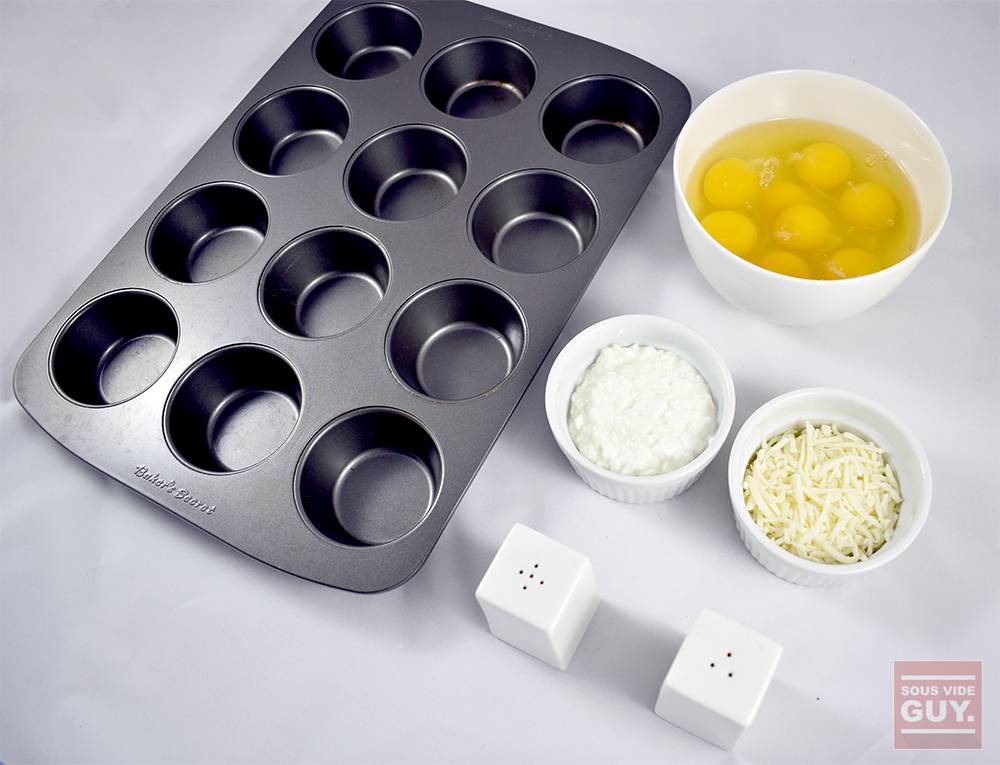
2. Blend the ingredients together
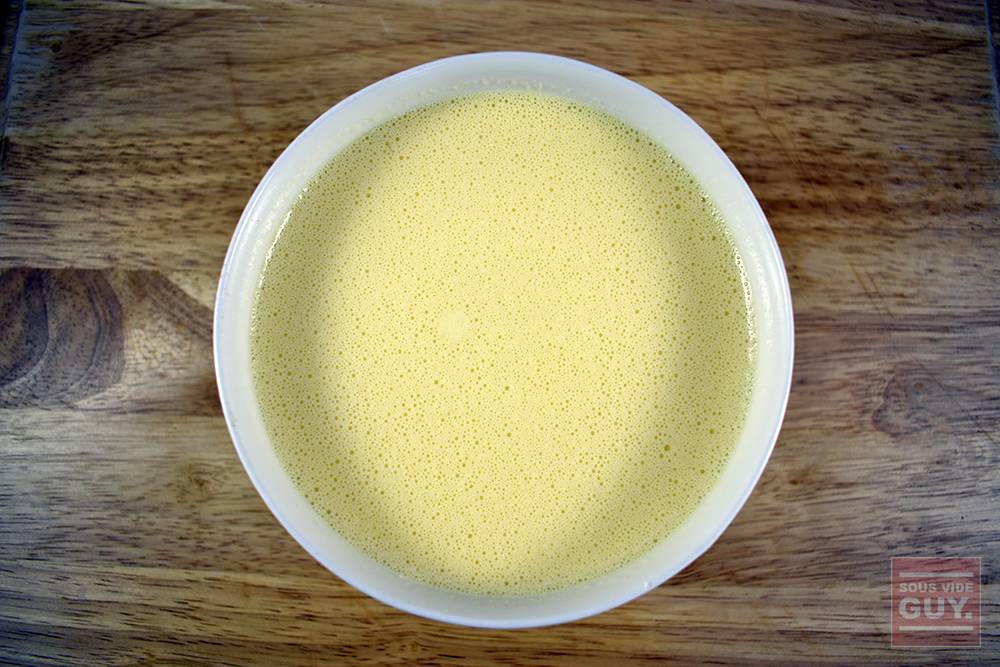
3. Pour egg mixture into cupcake pan
This can be done by using a cupcake liner or without. Cupcake liners make it easier to extract them from the pan when frozen.
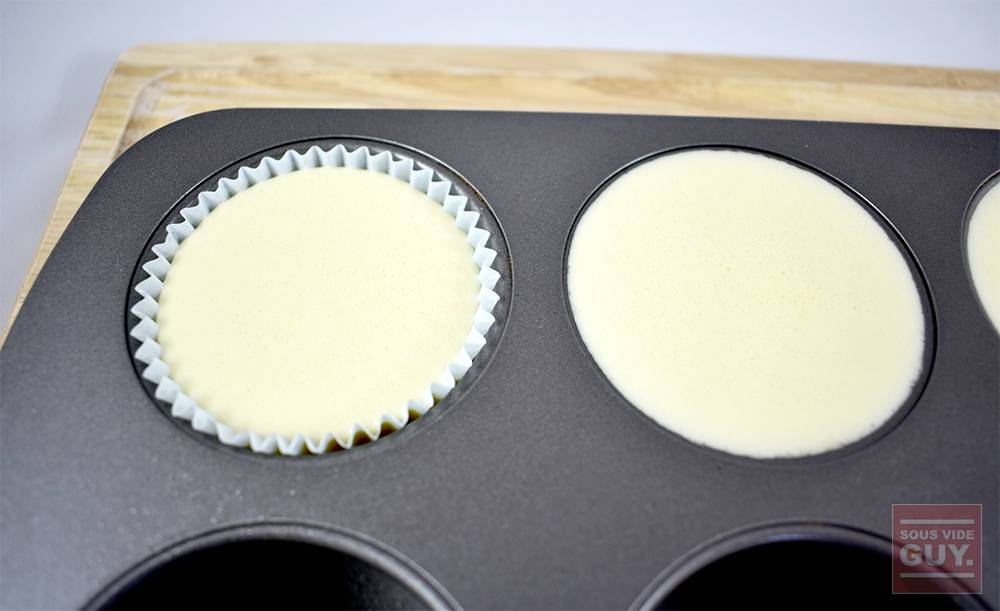
4. Freeze egg bites
The first time I made these I let them freeze overnight; the second time I made them, I only waited about 2 hours and they were frozen enough. If you don’t use cupcake liners, just wait 5 minutes until the edges begin to melt a bit, or take a knife and score the edges to loosen them.
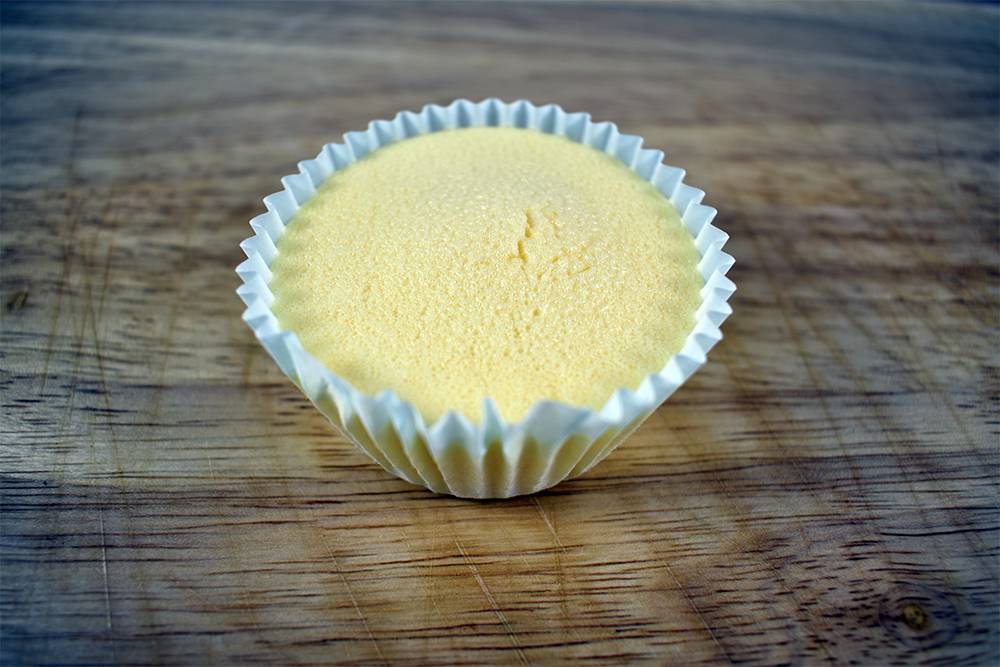
5. Vacuum seal the frozen egg bites
Once frozen, pull out each egg bite and vacuum seal them. I place multiple egg bites in a single bag – but be sure they don’t touch or else they’ll fuse together to make one super-egg bite. Unless that’s part of your plan. Here’s an example of what not to do. Luckily I only messed up once.
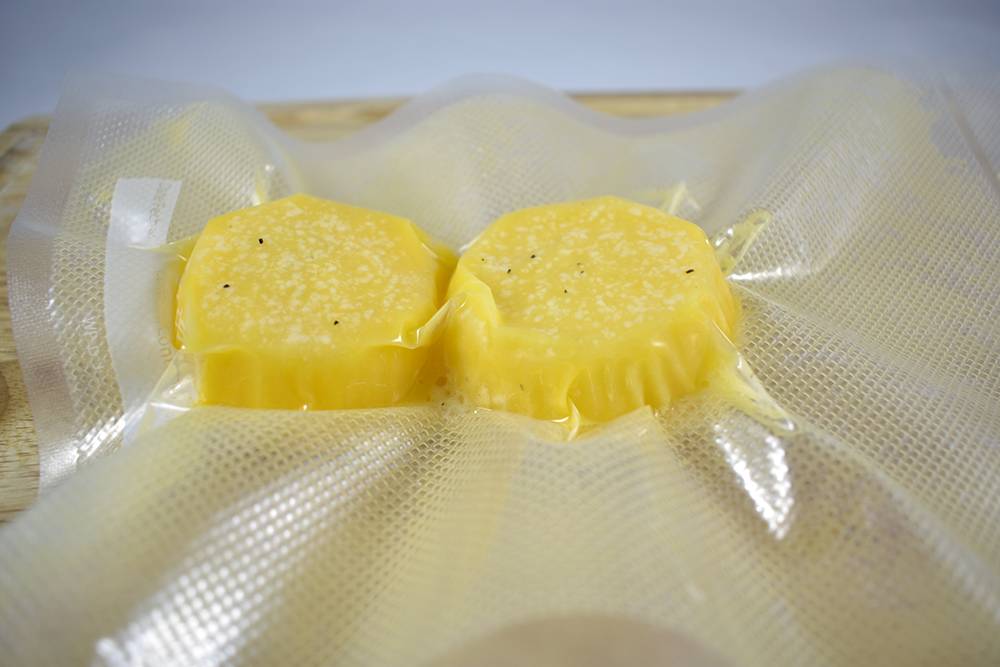
6. Sous vide the egg bites
Place the vacuum sealed egg bites into your pre-heated water bath at 173 degrees F for 25 minutes – 45 minutes. Since this method does not use canning jars, it doesn’t take quite as long to cook, even from a frozen state. Here is a shot of them cooked for 25 minutes and finished with a quick torch.
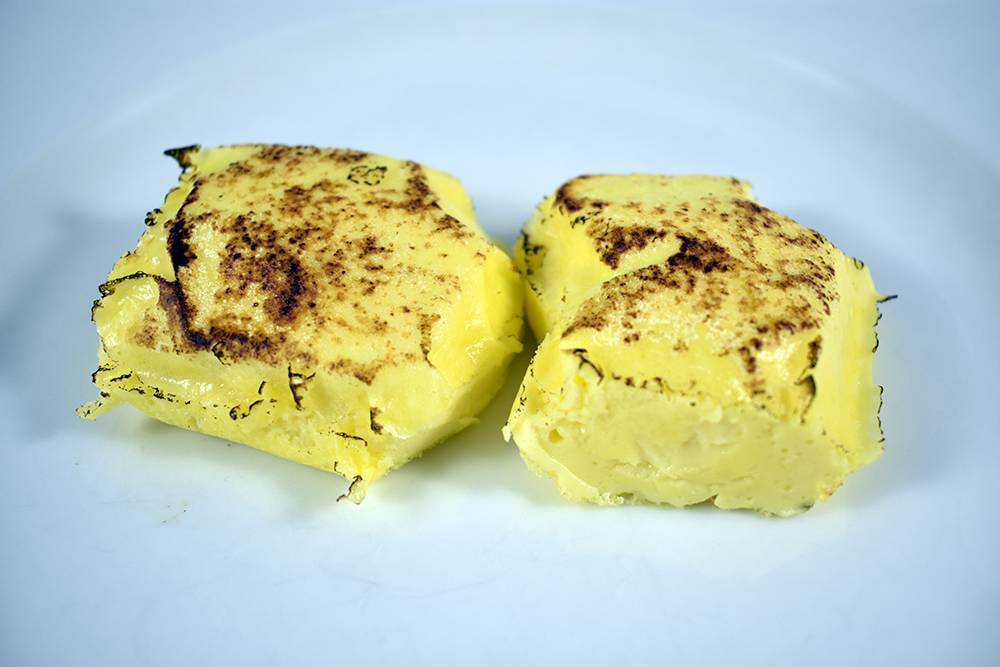
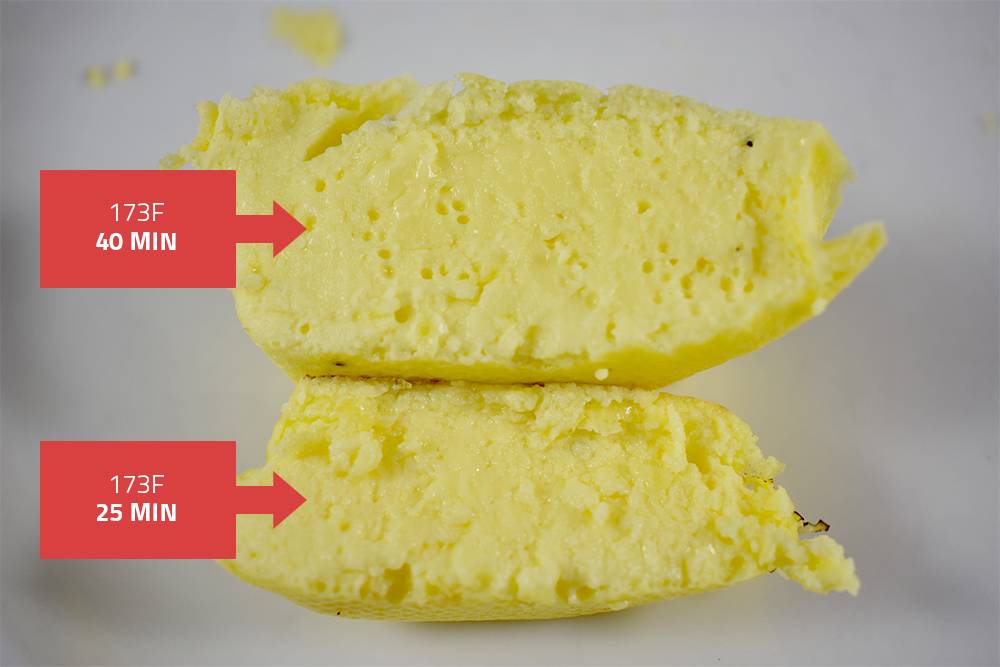

I left the liners on when I vacuum sealed and found the stuck to the egg bites. Next time no liners. Also, do you re-heat in vacuum sealed bags or remove before microwaving?
Sorry I might have explained it poorly! The liners should be taken off prior to sealing; the liners are mainly used so that they’re easier to pull out of the pan when frozen. Without the liners, the eggs are just a bit harder to get out of the pan unless you let them thaw for a few minutes.
Sounds like a great idea! Thanks! Can I assume that you put the egg bites into the heated water straight out of the freezer? New to sous vide. I love fixing egg bites and this would be great to do if I’m having company for breakfast.
That’s right, they go into the water right out of the freezer. That way they retain their shape better.
OK, tried it. As soon as the eggs thawed out, they all ran together and are now schmeared all over the vacuum bag. I’ll have to scrape them out with a knife. Do you have a magic vacuum sealer? There’s no way they can retain their shape once they’ve thawed into liquid again.
I am having the same problem. Right from the freezer into the water, I have bags full of egg. What a waste of time. So disappointed.
I’m looking forward to trying these, since they are added carbs in the Starbucks version, making them difficult for me (Type 1 diabetic) to eat except as a rare treat.
Regarding a PP experience with the eggs thawing while cooking and running together, it would seem to me that a really good vacuum seal is required to keep them in their own little “pockets” in the bag.
I’m also considering ricotta instead of cottage cheese, along with the addition of some cheddar (very finely shredded or grated). I’ll let you know if it works out. Thanks for posting this!
I use ricotta and cheddar cheese in my egg bites and they’re phenomenal.
Instead of a cupcake pan try a silicon mold. I bought some flower shaped ones that are 4 ounces per cavity to make fairy cakes. They work for this as well. They come in non-floral boring shapes too! (but I used what I had!). The advantage is that you can “peel them off of the frozen egg bites and skip the liners.
I’m thinking that a cupcake pan with silicon, rather than paper, liners might work well too. And silicon can endure high heat so maybe they can even be left in the silicon container during sous vide, which I will be trying shortly!
But if you leave them in the silicon do you still vacuum seal them?
Yes. You can freeze each individual “bite” in a muffin tin, cupcake mold, whatever shape holds your serving size. But yes, you still need to vacuum seal them to sous vide. Well, you can place them in a freezer bag and use the displacement method to “vacuum seal”
I’ve seen recipes for baking, microwaving and even poaching in a pan, but that’s not Sous Vide, which gives a whole different texture and is the subject of this web site.
Google egg bites and you’ll find tons of ideas on how to cook these. Have fun!
I made these today and they were really good! Now my question is how do you reheat them? I only cooked 1 package and still have the others in the freezer. Do you cook them all at once and reheat them or do you just cook them as you want them?
I am ready to experiment by mixing the ingredients then pouring them into a silicone mold that has a 2.5-4 oz capacity “cups” and putting that directly into my sous vide machine that only uses convection for heat distribution in the water. I expect to have to make adjustments to get the silicone mold to sit in the water at the right height as the silicon is lighter than water.
If anyone has already tried this, please share your experience.
I want to skip the freezing step and vacuum sealing if possible. I understand that the egg bites will keep for 7-10 days in the fridge once cooked.
I tried this today, but my bags kept floating. I tried weighing them down with a plate, but still ended up with a bag full of liquid eggs at the end. How are you supposed to prevent the bags from floating? This is one of those recipes where it’s really important the contents stay right side up, otherwise it won’t maintain its shape.
I love this idea of freezing, as reheating with various methods has changed the texture. I will freeze them raw in the instant pot sous vide egg tray, then cook a couple at a time as we want to eat them. I steam them in the instant pot and do not use the sous vide attachment. Quick and easy.
Sigh, way too much work. Yeah, they were tasty, but I can scramble a couple eggs pretty fast. I froze in silicone muffin cups, but using freezer bags and displacement method didn’t work well. Gravity takes the cups to the bottom of the bag, and I couldn’t get all the air out and keep the cups laying flat, so I had floating bags and spilling cups as the eggs thawed. Quite a mess. IF I try again, I’ll use the vacuum bags.
Hey Tina —
So I wanted to love this recipe as much as you did. I tried it first, as written, I couldn’t get the foil muffin liners off the eggs quicker than they started to defrost, and the ones I put in the tin just greased, were cemented. I ended up throwing the whole pan away. I ordered the silicone muffin cups from Amazon and was committed to try again. Made the batter — poured into silicone molds — froze — they came out beautifully — I quickly sealed them with my vacuum sealer in bags and put them back into the freezer until I was ready to eat them. I cooked them this morning and I had the same problem, I couldn’t get them to get under the water. I ended up placing a bowl on top of them to keep them submerged. At 25 minutes from 173 degrees, they were still very liquid like. Since I put them into two separate bags, I left 6 more in the bath for another 30 minutes. The majority of the mixture stayed within the confines of the muffin cups, but some escaped and went onto the outside of them. I’ve literally spent the last hour scrubbing egg mixture off 12 silicone muffin cups. I’m going back to my jars.
Thank you so much for this recipe! This is the third time I’ve attempted egg bites and the first time I’ve been truly successful. The first time, I tried glass jars and blew the bottom off of one–what a mess, cleaning the egg goop out of the water and off the immersion heater. The second time, I tried a silicone mold in a freezer bag and it wouldn’t cook right and ended up spilling all over inside the bag.
This time though, perfection! I whipped everything up and froze in some (greased) muffin cups. The next day, I vacuum sealed 2-3 “muffins” in each bag, making sure to keep them separated so they wouldn’t mush together. This morning I threw a couple bags in the sous vide and weighed them down with a metal rack and it worked great! Yes, the eggs want to float (I’m guessing eggs are less dense than water) but it wasn’t hard to overcome that. The eggs stayed separated in their bags perfectly and came out cleanly and easily. I cooked them for 45 minutes but I think I’d go with 30 to 35 next time so they’re creamier.
Thank you!!
you don’t thaw them
Leave the frozen egg mixture in the silicone cupcake liners before vacuum sealing. Even with vacuum sealing the frozen eggs apart from each other the Bites didn’t hold their shape.
I finally got up the nerve to try cooking the eggs I made using this recipe and taking into account the many useful but conflicting comments. I poured the prepared egg mixture into muffin tins with paper liners. I froze them a week ago, then vacuum-packed the eggs with two together, still in their papers. They kept their form perfectly. Today I cooked all 3 packages for 35 minutes as directed. I’m eating one now- delicious and great texture. The paper muffin cup still contains the egg, and is discarded after scraping out the last morsels, much like eating a muffin. Perfection!
Hi! I suspect that the reason the vacuum sealed frozen egg bites float is that the batter or custard froze with too much air bubbles in them. Maybe next time let the custard sit and skim the bubbles off the surface before pouring them into their molds.
And another hint. Instead of lining the muffin tins with paper liners, try spraying or brushing the tins with butter then line them with cling wrap. Then peel off the plastic wrap before vacuum sealing them and putting them back in the freezer.
I put a 6-cup popover tin in a 13×7 casserole dish. Poured in the batter, covered with tin foil, and filled the casserole dish with water, above the line of the egg. The Joule handled the low water level fine, and the egg bites came out great!